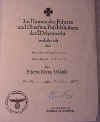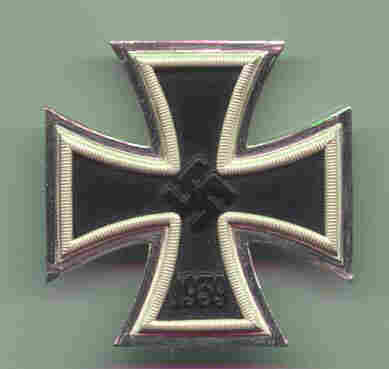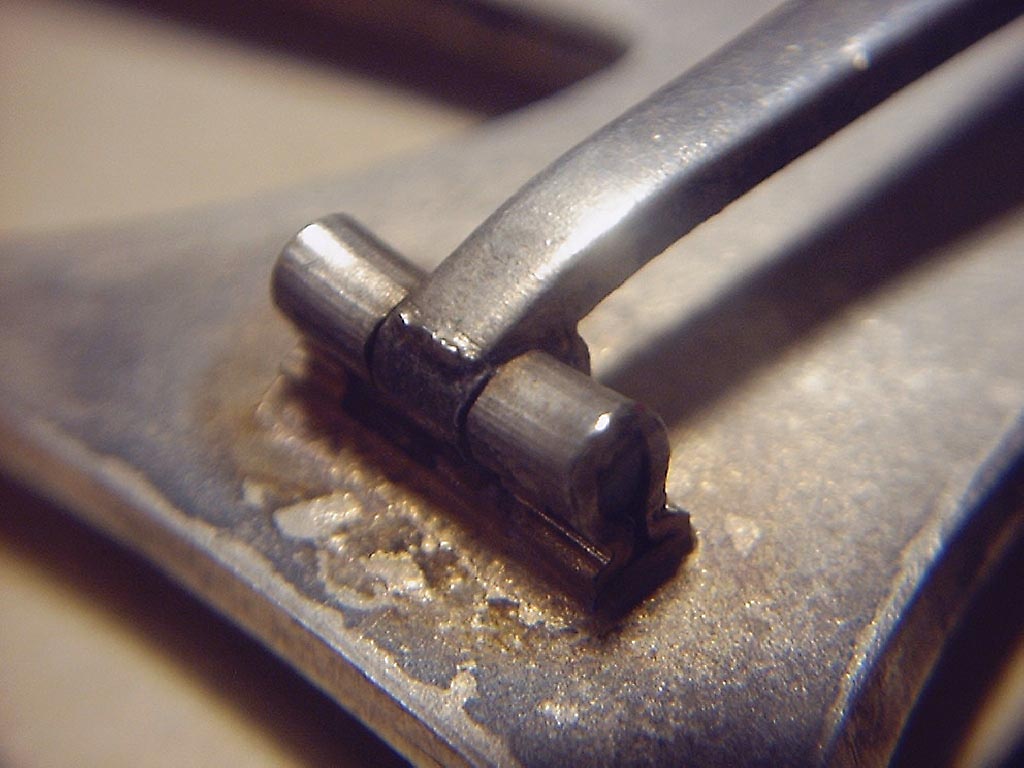

Home, Heer, Kriegsmarine, Luftwaffe, Fakes, RFI, Pictures,
EK I document provided by Mike Pinkus. Check out who has signed it.

The 1939 Iron Cross, Facts and Fakes.
Written by Doug Driggers
The Iron Cross of 1939 is easily the most identifiable military award in
history. The Eisernes Kreuz, or EK,
has it's roots deep in Germanic Military heritage, dating back to 1813.
Being reinstituted in 1870, 1914 and again on September 1st 1939. This
article will focus on the 1939 First and Second Class.
The Iron Cross of 1939, in it's standard form, should
measure approximately 44mm by 44mm and be made of German Silver (a combination
of copper, zinc and nickel) and in three separate pieces.
Some late war examples will be made of zinc and have a grayish
appearance. The standard Iron Cross
will consist of a silvered obverse frame, a blackened center section, and a
reverse silvered rim or a solid silvered back plate for the First Class. In both
Classes, the two frame halves should be neatly soldered together, sandwiching
the blacked center between them. The
soldering should be neatly done, leaving no big gaps between the frame halves.
The soldering of the hinge and catch, on the reverse of the First Class, should
also be done very neatly, without a lot of excess left on the badge.
Once assembled, the edges were burnished to a high sheen and lacquered to
prevent tarnish. These badges were
always of high quality, and even though the materials declined toward the war's
end, the workmanship never did.
The frame of the EK is generally sturdy in appearance and crisply detailed. You may encounter a matte-silver, or a milky white, or even a cream colored tone on the bead. This is the "frosted" effect used to contrast the polished rim. You will find a very fine solder line along the outer edge of the arms. The points of the arms should be slightly rounded at the tips, so they are not sharp to the touch. The points on some Crosses may be more rounded than on others this is normal, as all of the finishing work was performed by hand. The beading should be well defined; the arms should be of equal length and shape, and uniform in appearance. The frame of the Second Class consists of two identical halves. The mounting ring should be soldered to the center of the top arm, onto a small raised nub on the top arm. The latter being more rare, and is often found on unmarked pieces. If a maker's mark is to be found, it will be stamped into the ribbon ring that passes through the mounting ring. Many EK 2's have no mark at all. The frame of the First Class is identical to that of the Second Class on the obverse side. The reverse however is a solid silvered plate to which the hinge and catch for the pin, would be soldered to. Hinges came in several different styles and shapes, but were always sturdy and well formed. Catches were made from round wire or flat stock, bent into a "C" shape. The hinges and catches were finished in the same color as the back plate and were cleanly installed to the back plate. The pins... Well, the pins are a whole story in themselves. Pins generally varied from maker to maker. Most were of a "Coke Bottle" or "Wide Bellied" shape, being thin at the top and bottom, and thick in the middle. Some pins had the wide section lower on the pin, such as those made by B.H. Mayer (#26) and Deschler & Sohn (#1). There are two manufacturers that used pins that were almost straight from hinge to catch. That is to say, without a wide center at all. These would be found on EK's made by C.F. Zimmerman (#20, L/52) and Godet & Co. (L/50). All pins, no matter of style or shape, should be sturdy and not bend easily. The pins were generally stamped from 1 1/2mm flat stock, and smoothed along the edges, as not to fray the uniforms. Maker's marks, if any, can be found stamped onto the pin surface, or onto the back plate itself. In the case of Wactler & Lange (#100, L/55) the mark will be stamped on the underside of the pin.
The blacked centers are alike in basic design only. The swastika can vary in shape, size and height. The shape of the swastika should be uniform and symmetrical in appearance. The edges and ends of the swastika arms should not be rounded, and should be well defined. The height is a subject of some controversy, because a rumor has been around for years that the swastika should always be of equal height to the bead. This rumor holds it's roots in the old copies made by the firm of Rudolf Souval (L/58). His copies had an extremely low swastika. There are variances in the height of the swastikas found on original EK's. They can range from well below the bead, such as in a Deschler (#1) made EK, or even with the bead. I have a Juncker made EK 1, where the swastika is actually a micron higher than the beading, and is the most well formed one I have seen. The dates on an EK can vary greatly in the size, height, position and shape of the numerals themselves. The most noted of these being the extremely rare version where the "3" is rounded on it's crown (as it appears here) instead of flat. These were made prior to LDO regulations, and in small quantities. The centers were either chemically blackened, or painted black and then oven baked. The finish on period EK's can range from a very matte-black to a semi-gloss. It is not uncommon to find the swastika and/or date polished to a higher luster or even void of paint all together, to highlight the otherwise dark center. Most Iron Crosses will have their centers made from malleable iron, hence the name IRON Cross. Some however will be found to have centers made of non-ferrous metals such as brass or copper. Original examples were made for soldiers in the Kreigsmarine, as iron tended to rust quickly when exposed to seawater. These are believed to be private purchase items, as no records have been found to show official manufacturers of any alloy centered Iron Crosses. If you have any doubts about a non-ferrous centered EK, it is best to pass and go on to another. And yes, there are non-ferrous centered reproductions.
Below are some pictures of different parts of real EKs.
The reverse of a vaulted #"20" marked EKI.
Note the rounded "3".
This is a welled defined swastika from a Junckers made EKI.
 Hinge from a #1(Deschler und Sohn) marked EK.
Hinge from a #1(Deschler und Sohn) marked EK.
This hinge is from a #26 (B.H. Mayer) marked EK.
Known
Makers:
1st
Class
L/10,
L/11, L/12,
L/13, L/15,
L/16, L/16,
L/18, L/19,
L/50, L/52,
L/53,
L/54, L/55,
L/56, L/57,
L/58, L/59,
L/68, L/73
33,
35, 40,
41, 42,
44, 49,
52, 55,
56, 65,
66, 75,
76, 80,
93,
95, 96,
98, 100,
103, 106,
108, 113,
120, 123,
125, 128,
133,
137, 138,
142
Reproductions
The very best reproductions of the Iron Cross, were those made immediately after the war's end. These were made by the original manufacturers on their original dies, using original materials. These are virtually indistinguishable from wartime pieces. As materials ran out, and demand from souvenir hunting GI's increased, the manufacturers began using soft, lead based alloys and other inferior metals. Often the dies would become damaged or worn out, and new ones would be made to take their place. These were far from exact copies, and the quality of the detail suffered in comparison with the original dies. Their being a one piece stamping easily spots many reproductions. All of these will be soft and easily bend under little pressure. They also suffer from lack of detail, and the use of needle pins. As a rule, EKs were not made in one piece. The only original EKs made in one piece were early shinkel form EK1s. If you are unsure how to determine the authenticity of an early one piece shinkel EK, the best bet would be to pass on the item in question. No original Iron Cross should show signs of being cast in a mold. All original Iron Crosses were die stamped and made of three separate pieces. Also, no original Iron Cross was made with a needle pin. If you encounter an original EK with a needle pin, it may have been added as a replacement for a lost or damaged pin. But my advise would be to stay away from it.
The most current reproductions are good. Very good in some cases. They can, and do fool experienced collectors as well as the novice. The "green" collector is at the biggest risk, because these repros look as an Iron Cross should look according to many older reference books. Many dealers buy and sell these fakes as original. Some are unaware that what they are selling is a reproduction, and if brought to their attention, they are understanding and will give a refund. It is the dealer that sells a piece he knows is a fake, as an original, that can ruin a new collector's interest in this hobby. All collectors, novice or not, need to read as much as possible about any item they are wishing to purchase. Many collectors focus on one particular item, such as the Iron Cross, because it is easier to learn a lot about one item, than a little bit about a lot of different items. There are many good reference books and websites to help you in you quest for knowledge. Learning is a never-ending journey, if you are to stay ahead in the game of collecting. For every new reference book that comes out, five new reproductions hit the market. And until they are brought to the attention of the collecting community as reproductions, many a hard earned dollar will fall. Take it upon yourself to challenge a piece. Look at it, study it, and get to know every little detail. Make notes or keep a journal. Anything you do can only help you in the long run. Just because someone tells you apiece is authentic or has a fabulous story about the man who won it, without documented proof the story is meaningless.
There is a far more frightening EK repro on the market today. It first appeared around February 2000, and is rumored to be made in Japan, on original wartime dies. These dies were supposedly purchased from an original wartime manufacturer that went out of business a few years ago. The obverse of this repro will scare you to death. It is amazingly accurate. The stamping is clean and crisp. All of the detail stands out like any original you will come across. The problem... and there is only two... Is that the pin is a little too wide where it meets the hinge, and the hinge looks as if it had to be widened to allow for this. This repro has a pin that looks like that on a #20, or L/52 badge. But, when other details of an original badge from that maker are compared to it, the differences will be obvious.
I have
seen this badge marked 50 and also unmarked.
It has been sold on a certain e-auction site as a repro, and selling for
$20-40. But, I recently saw this
same badge on another Internet auction site, being touted as an original badge.
And yes, it brought over $100. Be
on the lookout for this one, because if they ever fix the slight pin/hinge
problem, or offer it in an EK2, we are all in trouble.
Speaking
of EK2's, there is a couple of good repros floating around. The first one has
been around for a few years and is very convincing. I even fell for one myself a
couple of years back. They to have some identifying points that you can be aware
of.
The
newest reproduction Iron Crosses are almost perfect. Almost being the key word.
The is at least one thing wrong with each and every one. Some are non-symmetrical,
others are prone to rust. Some have the date in the wrong location or shape, and
others use completely wrong pins or hinges.
Some use bogus manufacturer's numbers or have them in the wrong location.
But some, are virtually perfect. Only
the fact that they are known as reproductions, sets them apart.
I will try to cover a few known reproductions that are on the market
today. I will give a brief description and list a few of the "signs of
trouble " to look for.
The
first one seems to be the most abundant EK repro on the market today.
It is sold by dealers and all over internet auction sites. It is always
sold as original. It is a good copy, but you can spot it if you know what to
look for. It comes marked several different ways, but will always have a few
characteristics that will give it away.
* The obverse face is prone to rust. It usually occurs close to the beaded edge.
*
This repro comes with a variety of marks. Including, but not limited to: 2, 4,
5, 21,65, 100, L/15, and L/21.
* It also comes in a screw back version marked L/21
.
The
following is a list that could help you from purchasing a reproduction.
It is a few, simple key points to help determine originality. But in no
way can this be the final word. With the constant improvements on the
reproduction Iron crosses, a collector must study, study, study, reference books
and examine as many original pieces as possible. There are forums on the
Internet where collectors get together and discuss topics such as reproductions.
This is a great source for information and help.
Page 1, Photos of the Knights Cross from Jamie Cross.
Page 2, More photos from Jamie Cross
On to more photos of the Iron Cross first class.
Bibliography:
Andy Biggers' "Historic
Iron Cross" website
Gordon Williamson's " The Iron Cross a History
1813-1957"
V.E. Bowen's " The Prussian and German Iron Cross"